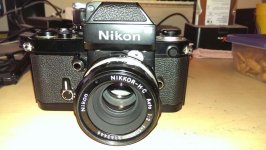I'd like to familiarize myself with current available Nikon equipment available now. I am smart enough to realize that the lens is probably more important than the camera when it comes to image quality.
First I'd like to buy a basic good used Nikon camera. I don't need the latest & greatest model, just something basic say 12-16 MP with a respectable ISO range.
There's something I've realized, and which you might want to consider.
If I were still shooting film, I'd be quite happy to stick with my F2 for as long as both it and I last. It's over forty years old, definitely not the most modern example of its type, but there is no newer 35mm film camera that can take any better pictures than it can. From its parent, the F, down through its current descendant, the F6, all take essentially the same optics, the same film, and can produce the same image quality.
Digital is a whole different world. The key to a digital camera, of course, is the image sensor. In the F2, the image sensor is called “film”, and no matter how old the camera is, you can use the best and most modern film in it. With a digital camera, unless you get into the really-high end cameras, such as a Hasselblad costing tens of thousands of dollars, you're stuck with whatever sensor around which your camera was manufactured. The sensor is key to image quality, and there are always better sensors coming out, with better cameras built around them (these cameras being better, if for no other reason than the better sensor).
I do not think it as realistic with a digital camera to expect that you will be content to use the same camera over a long period of time, and the further behind it is technologically when you get it, the sooner I think you can expect to become dissatisfied and want to replace it with something more modern.
Consider, for example, the first commercially-available DSLR, the
Kodak DCS 100 introduced to the market in 1991, at a price of about $20,000. It was basically a modified Nikon F3, with a digital sensor, and a separate, suitcase-sized data processing and storage unit containing a 200-megabyte hard drive to store the pictures. It had a resolution of only 1.3 megapixels—less than even the crappiest of modern point&shoot digital cameras.
In 1991, it was very impressive, and any photographer would have loved to have one. How satisfied would you be to still be using one today?
How about a
Nikon D1, the first pure Nikon DSLR, available in 1999 at a price of $5,500? A true Nikon professional-quality camera, now self-contained (no more suitcase-sized external unit attached to it by a cable). And a whopping 2.7 megapixels of resolution. Again, an impressive camera for its time,and in 1999, who among us wouldn't have loved to have one? But again, the crappiest of modern point&shoot digital cameras has much better resolution. Would you be content, today, with only 2.7 megapixels?
You're thinking you'll be happy with 12-16 megapixels? Are you sure? Perhaps you will. 16 megapixels cant be too bad, since that's the resolution of the D4 which is ostensibly Nikon's current “flagship” model. But most modern DSLRs, including Nikon's bottom-of-the-line D3300, have 24-megapixel resolution, and a few have 36-megapixel resolution. A few years from now, 36 megapixels will probably be the minimum, and we'll probably be seeing even higher resolutions. Will you still be happy with 12 or 16 megapixels then? Maybe you will, but it's something you might want to think about?
I'd also like some suggestions for a GREAT variable wide-angle lens say something like a 12-60 and also a really good 35mm prime lens.
There is something you need to know about lens sizes and DX-format DSLRs. Most of Nikon's DSLR are DX-format, meaning that the sensor is significantly smaller than a standard 35mm frame. They are, in fact, roughly the size of the short-lived APS film format.
You may see references to a “crop factor”, usually specified as being 1.5 for these cameras, but by my own math, 1.55 is actually more accurate. Since the sensor is smaller than a 35mm frame, it will cover a smaller part of the image projected by any lens, making that lens on a DX-format camera equal to a longer lens on a 35mm. That 35mm prime that I think you intended to specify as a wide-angle lens would actually be a standard-length lens for a DX-format camera; equal to a 54.25mm lens on a 35mm camera. If you want the equivalent angle of view on a DX camera that a 35mm lens would give on a 35mm camera, then what you really want is a 35÷1.55=22.6mmm lens. In place of that 12mm to 60mm, what you really want is {12,60}÷1.55 = 7.75mm to 38.7mm.




